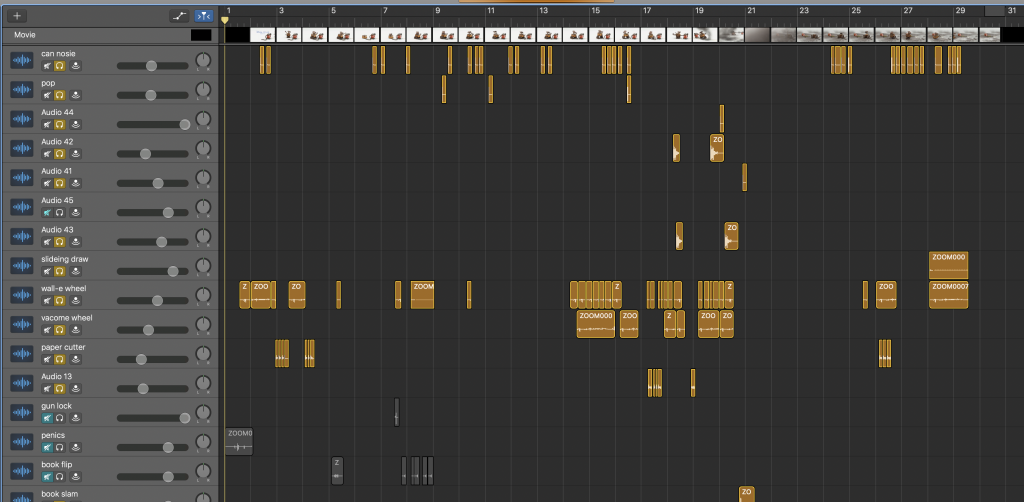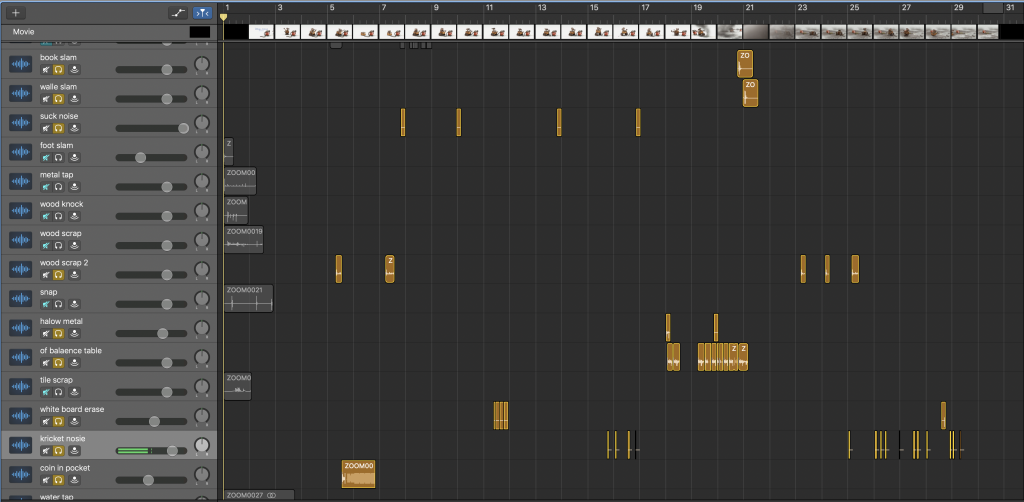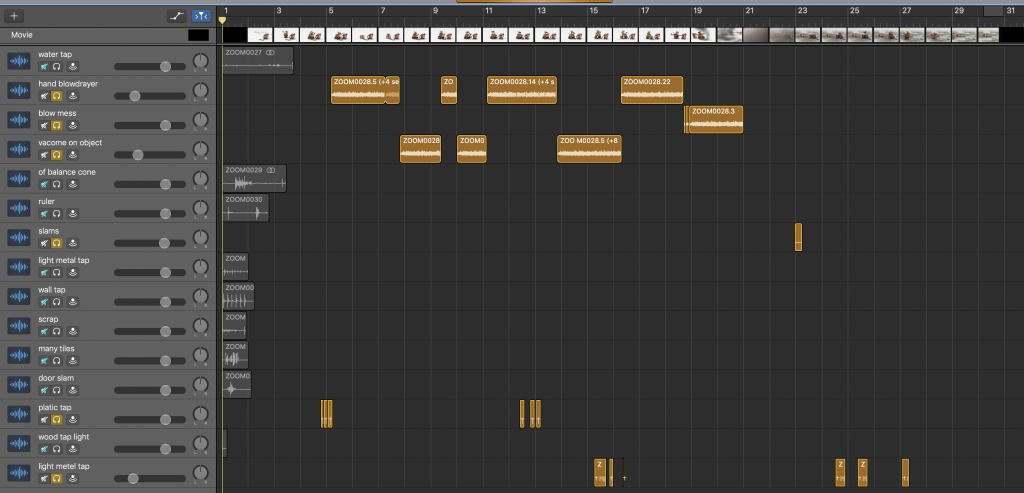For this task, we have to input sound into the video that had no sound in the video and the video was a clip of Wall-e.
Whiles I alright knew some information of Foley I thought it would be better to look back on the information and maybe learn something new.
Research
So, to start the research I thought that I should look at examples of Foley thought websites and videos.
There was one YouTube channel that I feel like that show a good example of Foley and their channel was called “insider” as there show not just how Foley artists doing their jobs as it also has them talking about their jobs and how the job is done.
The first video of them I saws was one when their explain how to created animal sound in movies and the Foley artist “Marko Costanzo” and he even shows examples of how he created the sounds used in movies like “Ice Age” and on the video, he mimics the foots steps on the mammoth and he does this with an “tree trunk the is wrap in leather” make in the sound of the stomp or like an animal. (Insider, 2020)
Another video that I found useful was called “The Magic of Making Sound” as it shows Foley artist form “Warner Bros. Studio” also doing Foley their jobs with Foley artist ‘Alyson Moore’ talking about how people take sound for granted and she shows an example of what she does.
In the video, their even explain the quick history of Foley and about Jack Foley the creator the father of sound to which their quote “the art of foley goes back to the old radio days” and also says “jack foley came in and he thought if I do those sounds in sync with the picture I’ve just took an hole step out” And it tell us how jack foley’s legacy in sound came to be after the film “talkies” swept Hollywood and since then then addition of sounds in post-production is called the art of foley.
On the video there show example of what sound there would use for foots steps in the forest to which there use “vhs tapes” which could sound link the crunching of leaves in a forest and when there shows the example of walking on snow it show them walking on “play sand with a bag of corn-starch on the side” to add an crunch every so often.
While there was trying to mimic the weather there had some trial and error to get the sound that right as if the sound doesn’t fix right then it could have an effect on the audience as a whole.
What I believe what is difficult with creating sound for weather is the interaction of the object as something like in the video as it show the rain hitting an hat to which there use a wellington boot, watering can and their own hand and the reason that their use their own hand was because in the scene the actor is in a forest and if we just have water pouring on the wellington boot it wouldn’t sound right as he in a forest and the rain would hit the leaves in the trees first so there pour the water on their hand to make it sound like the water is dripping on the hat in the scene.
In the video it also says that “if Foley artist does there job right you won’t even notice” and I feel that the quote is important as if we do not notice a difference that means they’re doing their jobs right.(Great Big Story, 2020)
In another video the Foley artist “John Roesch” talk about his experiences on this line of work, he talks about how difficult and how fun Foley is and the narrator tells us how john did sounds in movies from “et to interstellar”.
In the video, it also shows how the building was constructed “just from the demand of Foley with floors that go all the way down to earth and a splash pool to hold gallons of waters. (WIRED, 2020)
MaterClass talks about Foley and the understanding behind the subject that gives quick and easy exploitation on the topics like “what is Foley Art” and “the different type of Foley.”
According to the website there are 3 type of Foley which are.
- Feet
- Movement
- Specific
Feet are the most common sound for Foley artist as it mostly focusses on footsteps from the tiles that there walk on to the type of shoes that they wear.
Movement is the more subtle sound effect as something like brushing of two-character can enhance a scene.
Specific are uses for a specific object like the creaking of the door to the ringing of the phone.
Also give some example of why “Foley effects enhance a film”
- Foley sound make a scene more realistic
- Foley sound make a scene more immersive
- More believable ambient sounds
- It’s too quiet without Foley effects
This enhances the film because without these key points the film would turn out horrible as the sound might not fit right with the movement or specifics object and because of that it would make the viewers not like the film more. (MasterClass, 2020)
Another website that I look into foley artist and the art of foley was call “what is a foley artist? How they bring movies to life” to which Maio also quotes “foley artists bring the most mundane tasks to life”
On the website it also shows example of videos one that is titles “how the sound effects in A’ Quiet Place’ were made” and on the video it explains how the film have a lack of sound.
but that doesn’t mean that it not there.
In the video it also shows example of the props there use in the film an example of this is when an foley artist tap of metal and then it shows in the film and we can hear the tapping as well and one unique sound was created was when there uses an stun gun to a patch of grapes for the uses of echolocation for the monster.
Later on, in the video it shows the editing proceeds to which the us the sound of the stun gun and slow it down for the sounds for the monster. (Maio,2020) (insider, 2020)
Evaluation
This video is the complete task that I have created using the sound that I have collected in a lesson. In a team of three, we just went around college and recorded different sounds. Example of this is taping on metal, sliding draws, book slam onto a table and others.
When we collected the sounds we import the sounds onto the computer and then onto GarageBand with the file name “Wall E No Sound.m4v”.
After I put the sounds into GarageBand I first named all the sounds as it will be easy to know what I was doing and what sounds I could use for the task.
In total, I had 34 sounds that I could use for the task and I feel like I would have gotten more sounds if I was in a team with people I knew and if one of my teammates was to interact more with the tasks as he loses interest easily and that had an effect on me.
When all of the audio was named I first watch the video to see what I have to work with and I first added movement mainly the wheels as I believe that was one of the key points and I added the audio throughout the video and then created a new track for the movement of Wall-e repeating the step.
After I added movement of the wheels I then added sounds with Wall-e interacting with the vacuum like the tapping or when the vacuum is attached to Wall-e’s body.
When I was finished with that part of the task I mainly focused on the movement of Wall-e and the added the sound like the movement of the arms or the movement of the eyes.
When I added the what I thought was the most major needed sounds I then focused on the minor sound like the cricket sounds and the random sounds that I thought was best when the vacuum was out of control.



The audio that is lit up is the sound I use in the completed task that had a total of 25 audio with 12 of the audio being new tracks that were adjusted with the plugs-ins or pitch correction.
Whiles, I was placing the audio I sometimes loop the audio and other time I created a new audio region.

The image about shows a loop track of audio that was used to show Wall-e shaking from fear.

The image about shows a group of the audio region that was used for the movement of the eyes after Wall-e remove vacuum tube for his eyes.
There was a list of sound that I originally thought that I would not be used in the finished task like the shake of coins in a pocket as I didn’t think that it would not work well anything but it went really well with the shaking of Wall-e or how a paper cutter movement sound works well with the movement of Wall-e.
The thing I found the easy about the task is that matching the audio with the movement of the video because of the software i can zoom into the right frame to impute the audio in at the times when the movement was needed and when the movement ends and I think that the collecting of sound was easy as making the sound was easy as breathing.
The thing I found difficult about the task is that trying to find the right sound with the right integration, an example of this is with the movement of the eyes as I didn’t really know what sounds I should use or how to change the sounds to what I really wanted and if I understand the software better and how to use it to an better understanding then the work I produce would be alot more better.
Over all i really proud of the final outcome of the task as a whole.
Coming into this task I believe that I was going to be difficult, I would not enjoy this very much and that I wouldn’t like the final work I produce and I was partly right as it was difficult but I really enjoy doing this and I love how then final task came out.
What I believe is the best parts about the task is the cricket noise as it sounds like the real thing but I just use a whiteboard rubber wiping a board and then added pitch shifter, I also believe that the vacuum noise is really good when the vacuum started to blow all the rubbish out of the tube, the suction of the vacuum work well as well as it is goes on and when the tube is attached to wall and sucks up the cricket I believe that work really well and I believe that the best parts was how the sounds work well with one another as I can tell what the movement or interaction sound similar to what’s it supports to sound like.
To improve the completed task I would try to add some sounds that would work well with the vacuum when it goes out of controls and if I knew how to uses the plug-ins I feel like I could improve the task a lot and if I had a better understanding on how to adjust the volume and I believe that if I was on a team with peoples that didn’t lose interest easily so that we can record the different type of sound and I could also look at the original video of the video to see what the professional has done and compare it the work that I have produced.
youtube. 2020. How Animal Sounds Are Made For Movies And TV | Movies Insider. [online] Available at: <https://www.youtube.com/watch?v=l2WCrXc7J-I> [Accessed 24 November 2020].
Youtube.com. 2020. The Magic Of Making Sound. Great Big Story [online] Available at: <https://www.youtube.com/watch?v=UO3N_PRIgX0> [Accessed 1 December 2020].
youtube. 2020. How The Sounds From Your Favorite Movies Are Made, WIRED online] Available at: <https://www.youtube.com/watch?v=0GPGfDCZ1EE> [Accessed 1 December 2020].
Film 101: Understanding Foley Sound and Why Foley Sound Is Important. 2020. Art & Entertainment. [online] Available at: <https://www.masterclass.com/articles/film-101-understanding-foley-sound-and-why-foley-sound-is-important#the-origins-of-foley-art.%202020.%20Film%20101:%20Understanding%20Foley%20Sound%20And%20Why%20Foley%20Sound%20Is%20Important.%20[online]%20Available%20at:%20%3Chttps://www.masterclass.com/articles/film-101-understanding-foley-sound-and-why-foley-sound-is-important#what-is-foley-art%3E%20[Accessed%208%20December%202020].> [Accessed 15 December 2020].
Maio, A., 2020. Foley: The Art Of Sound Design. [online] StudioBinder. Available at: <https://www.studiobinder.com/blog/what-is-a-foley-artist/> [Accessed 15 December 2020].
Youtube.com. 2020. How The Sound Effects In ‘A Quiet Place’ Were Made | Movies Insider. [online] Available at: <https://www.youtube.com/watch?v=WnozP8OWeik&feature=emb_title> [Accessed 15 December 2020].